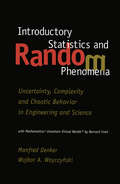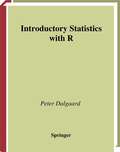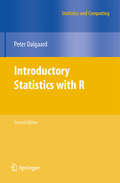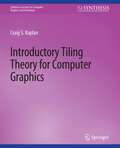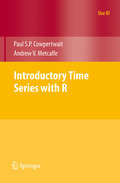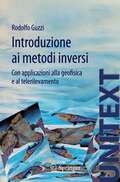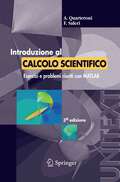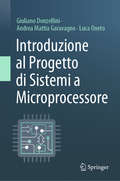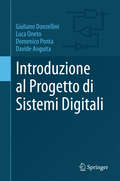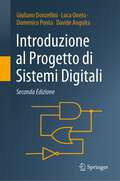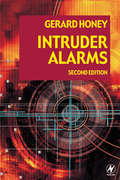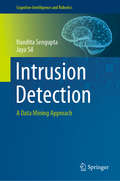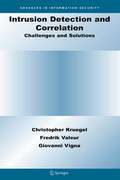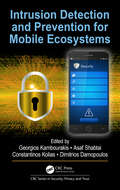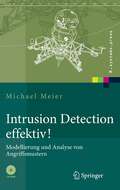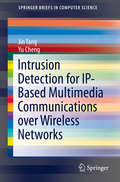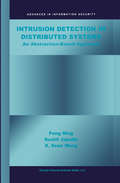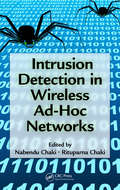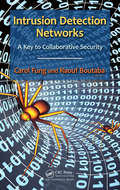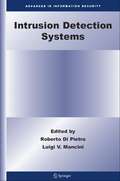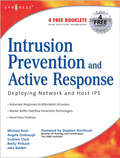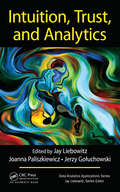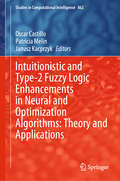- Table View
- List View
Introductory Statistics and Random Phenomena: Uncertainty, Complexity and Chaotic Behavior in Engineering and Science (Statistics for Industry and Technology)
by Manfred Denker Wojbor WoyczynskiIntroductory Statistics with R (Statistics and Computing)
by Peter DalgaardThis book provides an elementary-level introduction to R, targeting both non-statistician scientists in various fields and students of statistics. The main mode of presentation is via code examples with liberal commenting of the code and the output, from the computational as well as the statistical viewpoint. Brief sections introduce the statistical methods before they are used. A supplementary R package can be downloaded and contains the data sets. All examples are directly runnable and all graphics in the text are generated from the examples. The statistical methodology covered includes statistical standard distributions, one- and two-sample tests with continuous data, regression analysis, one-and two-way analysis of variance, regression analysis, analysis of tabular data, and sample size calculations. In addition, the last four chapters contain introductions to multiple linear regression analysis, linear models in general, logistic regression, and survival analysis.
Introductory Statistics with R (Statistics and Computing)
by Peter DalgaardThis book provides an elementary-level introduction to R, targeting both non-statistician scientists in various fields and students of statistics. The main mode of presentation is via code examples with liberal commenting of the code and the output, from the computational as well as the statistical viewpoint. Brief sections introduce the statistical methods before they are used. A supplementary R package can be downloaded and contains the data sets. All examples are directly runnable and all graphics in the text are generated from the examples. The statistical methodology covered includes statistical standard distributions, one- and two-sample tests with continuous data, regression analysis, one-and two-way analysis of variance, regression analysis, analysis of tabular data, and sample size calculations. In addition, the last four chapters contain introductions to multiple linear regression analysis, linear models in general, logistic regression, and survival analysis.
Introductory Tiling Theory for Computer Graphics (Synthesis Lectures on Computer Graphics and Animation)
by Craig KaplanTiling theory is an elegant branch of mathematics that has applications in several areas of computer science. The most immediate application area is graphics, where tiling theory has been used in the contexts of texture generation, sampling theory, remeshing, and of course the generation of decorative patterns. The combination of a solid theoretical base (complete with tantalizing open problems), practical algorithmic techniques, and exciting applications make tiling theory a worthwhile area of study for practitioners and students in computer science. This synthesis lecture introduces the mathematical and algorithmic foundations of tiling theory to a computer graphics audience. The goal is primarily to introduce concepts and terminology, clear up common misconceptions, and state and apply important results. The book also describes some of the algorithms and data structures that allow several aspects of tiling theory to be used in practice. Table of Contents: Introduction / Tiling Basics / Symmetry / Tilings by Polygons / Isohedral Tilings / Nonperiodic and Aperiodic Tilings / Survey
Introductory Time Series with R (Use R!)
by Paul S.P. Cowpertwait Andrew V. MetcalfeThis book gives you a step-by-step introduction to analysing time series using the open source software R. Each time series model is motivated with practical applications, and is defined in mathematical notation. Once the model has been introduced it is used to generate synthetic data, using R code, and these generated data are then used to estimate its parameters. This sequence enhances understanding of both the time series model and the R function used to fit the model to data. Finally, the model is used to analyse observed data taken from a practical application. By using R, the whole procedure can be reproduced by the reader. All the data sets used in the book are available on the website http://staff.elena.aut.ac.nz/Paul-Cowpertwait/ts/.The book is written for undergraduate students of mathematics, economics, business and finance, geography, engineering and related disciplines, and postgraduate students who may need to analyse time series as part of their taught programme or their research.
Introduzione ai metodi inversi: Con applicazioni alla geofisica e al telerilevamento (UNITEXT #32)
by Rodolfo GuzziNon è facile definire che cosa sia un problema inverso anche se, ogni giorno facciamo delle operazioni mentali che sono dei metodi inversi. Ad esempio riconoscere i luoghi che attraversiamo quando andiamo al lavoro o passeggiamo, riconoscere una persona conosciuta tanti anni prima etc. Eppure la nostra cultura non ha ancora sfruttato appieno queste nostre capacità, anzi ci insegna la realtà utilizzando i metodi diretti. Ad esempio ai bambini viene insegnato a fare di conto utilizzando le quattro operazioni. Guardiamo ad esempio la moltiplicazione, essa è basata sul fatto che presi due fattori e moltiplicati tra di loro si ottiene il loro prodotto. Il corrispondente problema inverso è quello di trovare un paio di fattori che diano quel numero. Noi sappiamo che questo problem può anche non avere una unica soluzione. Infatti nel cercare di imporre una unicità della soluzione utilizziamo i numeri primi aprendo un mondo matematico complesso. Probabilmente il più antico problema inverso fu fatto da Erodoto, attraverso l'interpolazione lineare. Il problema diretto è quello di di calcolare una funzione lineare, che fornisce un risultato quando si introducono due numeri, ma un problema inverso come quello dell'interpolazione lineare può avere una soluzione, nessuna soluzione, infinite soluzioni in relazione al numero e alla natura dei punti. Poiché esiste una stretta dipendenza tra il problema diretto e quello inverso, è buona norma impratichirsi con il problema diretto prima di affrontare il problema inverso. Questo approccio richiede che, soprattutto quando si ha a che fare con modelli fisico matematici, si sviluppi una strategia sul modello diretto, utilizzando tutti gli strumenti della conoscenza. Ad esempio cercare le soluzioni di tutte le possibili combinazioni che possono essere ottenute utilizzando vari dati di input; fare una presentazione grafica dei risultati che ci permettono, da una o più curve, ricavare i limiti di utilizzabilià del modello. I problemi inversi hanno avuto una notevole influenza sulla scienza, anche se l'approccio convenzionale è quello di privilegiare il problema diretto. Tuttavia con l'avvento dei calcolatori i problemi inversi hanno beneficiato di parecchi vantaggi tra cui quello di meglio controllare le instabilità computazionali e di affrontare problemi che richiedevano un grande sforzo computazionale, se fatti a mano, che non avrebbero portato ad alcun risultato tangibile. Nonostante questo le percentuali di successo per la soluzione dei problemi inversi sono ancora basse e quindi c'è necessità di nuovo e più approfondito lavoro che questo libro i tratteggia fornendo lo stato dell'arte della scienza dei problemi inversi con appliczioni alla geofisica, fisica dell'atmosfera e dell'oceano e terilevamento da satellite.
Introduzione al Calcolo Scientifico: Esercizi e problemi risolti con MATLAB (Unitext Ser.)
by Alfio Quarteroni F. SaleriQuesto testo è espressamente concepito per i corsi brevi del nuovo ordinamento delle Facoltà di Ingegneria e di Scienze. Esso affronta tutti gli argomenti tipici della Matematica Numerica, spaziando dal problema di approssimare una funzione, al calcolo dei suoi zeri, delle sue derivate e del suo integrale definito fino alla risoluzione approssimata di equazioni differenziali ordinarie e di problemi ai limiti. Due capitoli sono inoltre dedicati alla risoluzione di sistemi lineari ed al calcolo degli autovalori di una matrice, mentre un capitolo iniziale conduce lo studente ad un rapido ripasso degli argomenti dell'Analisi Matematica di uso frequente nel volume e ad una introduzione al linguaggio Matlab. I vari argomenti sono volutamente affrontati a livello elementare ed i paragrafi che richiedono maggior impegno sono stati opportunamente contrassegnati. In questa quarta edizione il linguaggio Octave (di distribuzione gratuita) si affianca a MATLAB.
Introduzione al Progetto di Sistemi a Microprocessore
by Giuliano Donzellini Andrea Mattia Garavagno Luca OnetoIl libro di testo è concepito per studenti di un primo corso sullo sviluppo di sistemi a microprocessore, nelle Facoltà di Ingegneria e di Scienze. Adattabile a diverse esigenze didattiche, non richiede conoscenze preliminari sui microprocessori e fornisce una solida introduzione all’argomento. L’apprendimento della teoria è facilitato da numerosi esempi ed esercizi, tutti risolti per esteso, e consolidato con la loro verifica funzionale tramite simulazione. Un sito web di libero accesso ospita il software di simulazione gratuito Deeds (Digital Electronics Education and Design Suite), creato e mantenuto dagli autori, e contiene tutto il materiale riguardante gli esempi ed esercizi presentati nel libro. Nel testo vengono prima introdotti i concetti generali, tramite un approccio progettuale che porta alla definizione di un piccolo microprocessore dimostrativo. Viene quindi presentato un secondo microprocessore appositamente pensato per la didattica, di cui se ne approfondisce la programmazione e l’interfacciamento. Il percorso didattico si conclude con numerosi esempi di progetto, verificabili tramite prototipi da realizzare su schede FPGA. Ideale per l’auto-apprendimento, grazie alla simbiosi ottimale con il simulatore Deeds, il libro può essere usato ugualmente con profitto indipendentemente da esso. Il testo racchiude la pluri-decennale esperienza degli autori nell’insegnamento e nello sviluppo di materiale didattico nell’ambito del progetto di sistemi digitali, aggiungendosi al libro precedente “Introduzione al Progetto di Sistemi Digitali” pubblicato dagli autori con Springer nel 2018.
Introduzione al Progetto di Sistemi Digitali
by Giuliano Donzellini Luca Oneto Domenico Ponta Davide AnguitaIl testo, concepito per studenti di un primo corso di reti logiche nelle Facoltà di Ingegneria e di Scienze, fornisce una solida conoscenza delle basi teoriche delle reti logiche. Parte dall’algebra booleana e dall’aritmetica binaria, e passando per le reti sequenziali e le macchine a stati finite, accompagna i lettori nella progettazione e simulazione di sistemi formati da controllore e datapath. L’apprendimento delle parti teoriche è facilitato dalla presentazione di numerosi esempi ed esercizi, tutti risolti per esteso. Un sito web di libero accesso ospita il software Deeds (Digital Electronics Education and Design Suite), creato e mantenuto dagli autori, e contenente tutto il materiale necessario per la simulazione con Deeds dei numerosi esempi ed esercizi affrontati nel testo. Strutturato in modo da adattarsi a diverse esigenze didattiche, questo testo non richiede conoscenze preliminari in campo elettronico o informatico. Inoltre, grazie al supporto fornito da Deeds, rapprensenta un libro ideale per l’auto-apprendimento. Sebbene il suo impiego ottimale sia in simbiosi con il Deeds, esso può essere usato con profitto anche indipendentemente dal simulatore. Il libro racchiude la pluri-decennale esperienza degli autori nell’insegnamento e nello sviluppo di materiale didattico nell’ambito del progetto di sistemi digitali.
Introduzione al Progetto di Sistemi Digitali
by Giuliano Donzellini Luca Oneto Domenico Ponta Davide AnguitaIl testo, giunto alla sua seconda edizione, è concepito per studenti di un primo corso di reti logiche nelle Facoltà di Ingegneria e di Scienze. Il testo fornisce una solida conoscenza delle basi teoriche delle reti logiche. Parte dall’algebra booleana e dell'aritmetica binaria e, passando per le reti sequenziali e le macchine a stati finiti, accompagna i lettori nella progettazione e simulazione di sistemi formati da controllore e datapath. Questa nuova versione è arricchita da un capitolo che introduce ai componenti FPGA, ai linguaggi HDL e alla realizzazione di prototipi su scheda FPGA. L’apprendimento delle parti teoriche è facilitato dalla presentazione di numerosi esempi ed esercizi, tutti risolti per esteso. Un sito web ospita il software Deeds (Digital Electronics Education and Design Suite), creato e mantenuto dagli autori, e contenente tutto il materiale necessario per la simulazione con Deeds dei numerosi esempi ed esercizi affrontati nel testo. Strutturato in modo da adattarsi a diverse esigenze didattiche, questo testo non richiede conoscenze preliminari in campo elettronico o informatico. Inoltre, grazie al supporto fornito da Deeds, rappresenta un libro ideale per l’auto-apprendimento. Sebbene il suo impiego ottimale sia in simbiosi con Deeds, esso può essere usato con profitto anche indipendentemente dal simulatore. Il libro racchiude la pluri-decennale esperienza degli autori nell’insegnamento e nello sviluppo di materiale didattico.
Intruder Alarms
by Gerard HoneyIntruder Alarms provides a definitive and fully up-to-date guide to the specification, systems design, integration, installation and maintenance of intruder alarm systems. It has been written to be the essential handbook for installation engineers and security professionals working in this rapidly expanding and developing area.The second edition includes new material on the use of remote signalling and networking and an expanded section on the integration of security systems, including real-world case studies. Information on police response policy, and the use of confirmed alarm technology has been updated, along with coverage of accreditation systems, NSI and ICON.This book has been endorsed by SITO (the UK's Security Industry Training Organisation) as a suitable text for students following the relevant SITO courses including the SITO / City & Guilds scheme 1851: Knowledge of Security and Emergency Alarm Systems.* The practical guide for installation engineers and security professionals* Essential reading for anyone responsible for the commissioning and maintenance of security alarm systems* New edition covers networking and integration issues
Intrusion Detection: A Data Mining Approach (Cognitive Intelligence and Robotics)
by Nandita Sengupta Jaya SilThis book presents state-of-the-art research on intrusion detection using reinforcement learning, fuzzy and rough set theories, and genetic algorithm. Reinforcement learning is employed to incrementally learn the computer network behavior, while rough and fuzzy sets are utilized to handle the uncertainty involved in the detection of traffic anomaly to secure data resources from possible attack. Genetic algorithms make it possible to optimally select the network traffic parameters to reduce the risk of network intrusion. The book is unique in terms of its content, organization, and writing style. Primarily intended for graduate electrical and computer engineering students, it is also useful for doctoral students pursuing research in intrusion detection and practitioners interested in network security and administration. The book covers a wide range of applications, from general computer security to server, network, and cloud security.
Intrusion Detection and Correlation: Challenges and Solutions (Advances in Information Security #14)
by Christopher Kruegel Fredrik Valeur Giovanni VignaDetails how intrusion detection works in network security with comparisons to traditional methods such as firewalls and cryptography Analyzes the challenges in interpreting and correlating Intrusion Detection alerts
Intrusion Detection and Prevention for Mobile Ecosystems (Series in Security, Privacy and Trust)
by Georgios Kambourakis, Asaf Shabtai, Constantinos Kolias and Dimitrios DamopoulosThis book presents state-of-the-art contributions from both scientists and practitioners working in intrusion detection and prevention for mobile networks, services, and devices. It covers fundamental theory, techniques, applications, as well as practical experiences concerning intrusion detection and prevention for the mobile ecosystem. It also includes surveys, simulations, practical results and case studies.
Intrusion Detection and Prevention for Mobile Ecosystems (Series in Security, Privacy and Trust)
by Georgios Kambourakis Asaf Shabtai Constantinos Kolias Dimitrios DamopoulosThis book presents state-of-the-art contributions from both scientists and practitioners working in intrusion detection and prevention for mobile networks, services, and devices. It covers fundamental theory, techniques, applications, as well as practical experiences concerning intrusion detection and prevention for the mobile ecosystem. It also includes surveys, simulations, practical results and case studies.
Intrusion Detection effektiv!: Modellierung und Analyse von Angriffsmustern (X.systems.press)
by Michael MeierIntrusion-Detection-Systeme werden zum Schutz vor Angriffen von IT-Systemen eingesetzt. Sie erkennen Missbrauch, indem sie Systemereignisse mit bekannten Angriffsmustern vergleichen. Der praktische Einsatz dieser Systeme ist häufig von Fehlalarmen geprägt. Die Ursache liegt in unzureichenden Angriffsmustern. Der Autor stellt hier Ansätze zur Steigerung der Wirksamkeit von Missbrauchserkennung im praktischen Einsatz vor. Systematisch untersucht er Anforderungen an die Repräsentation von Angriffsmustern. Er entwickelt einen an Petri-Netze angelehnten Ansatz zur grafischen Modellierung, Veranschaulichung und Erkennung von Angriffsmustern.
Intrusion Detection for IP-Based Multimedia Communications over Wireless Networks (SpringerBriefs in Computer Science)
by Jin Tang Yu ChengIP-based multimedia communications have become increasingly popular in recent years. With the increasing coverage of the IEEE 802:11™ based wireless networks, IP-based multimedia communications over wireless networks are also drawing extensive attention in both academia and industry. Due to the openness and distributed nature of the protocols involved, such as the session initiation protocol (SIP) and the IEEE 802:11™ standard, it becomes easy for malicious users in the network to achieve their own gain or disrupt the service by deviating from the normal protocol behaviors. This SpringerBrief presents real-time intrusion detection techniques that can quickly track the malicious behaviors which manipulate the vulnerabilities from either the 802.11™ or the SIP protocols. More specifically, this book presents interdisciplinary techniques to achieve an effective real-time intrusion detection system, which interweaves medium access control (MAC) protocol analysis, cumulative sum (CUSUM) based detector design, a novel Markovian model for CUSUM detectors, sketch-based traffic modeling, and wavelet based signal processing techniques.
Intrusion Detection in Distributed Systems: An Abstraction-Based Approach (Advances in Information Security #9)
by Peng Ning Sushil Jajodia Xiaoyang Sean WangIntrusion Detection In Distributed Systems: An Abstraction-Based Approach presents research contributions in three areas with respect to intrusion detection in distributed systems. The first contribution is an abstraction-based approach to addressing heterogeneity and autonomy of distributed environments. The second contribution is a formal framework for modeling requests among cooperative IDSs and its application to Common Intrusion Detection Framework (CIDF). The third contribution is a novel approach to coordinating different IDSs for distributed event correlation.
Intrusion Detection in Wireless Ad-Hoc Networks
by Nabendu Chaki Rituparna ChakiPresenting cutting-edge research, Intrusion Detection in Wireless Ad-Hoc Networks explores the security aspects of the basic categories of wireless ad-hoc networks and related application areas. Focusing on intrusion detection systems (IDSs), it explains how to establish security solutions for the range of wireless networks, including mobile ad-hoc
Intrusion Detection Networks: A Key to Collaborative Security
by Carol Fung Raouf BoutabaThe rapidly increasing sophistication of cyber intrusions makes them nearly impossible to detect without the use of a collaborative intrusion detection network (IDN). Using overlay networks that allow an intrusion detection system (IDS) to exchange information, IDNs can dramatically improve your overall intrusion detection accuracy.Intrusion Detect
Intrusion Detection Systems (Advances in Information Security #38)
by Roberto Di Pietro Luigi V. ManciniTo defend against computer and network attacks, multiple, complementary security devices such as intrusion detection systems (IDSs), and firewalls are widely deployed to monitor networks and hosts. These various IDSs will flag alerts when suspicious events are observed. This book is an edited volume by world class leaders within computer network and information security presented in an easy-to-follow style. It introduces defense alert systems against computer and network attacks. It also covers integrating intrusion alerts within security policy framework for intrusion response, related case studies and much more.
Intrusion Prevention and Active Response: Deploying Network and Host IPS
by Michael Rash Angela Orebaugh Graham ClarkIntrusion Prevention and Active Response provides an introduction to the field of Intrusion Prevention and provides detailed information on various IPS methods and technologies. Specific methods are covered in depth, including both network and host IPS and response technologies such as port deactivation, firewall/router network layer ACL modification, session sniping, outright application layer data modification, system call interception, and application shims.Corporate spending for Intrusion Prevention systems increased dramatically by 11% in the last quarter of 2004 aloneLead author, Michael Rash, is well respected in the IPS Community, having authored FWSnort, which greatly enhances the intrusion prevention capabilities of the market-leading Snort IDS
Intuition, Trust, and Analytics (Data Analytics Applications)
by Jay Liebowitz Joanna Paliszkiewicz Jerzy GołuchowskiIn order to make informed decisions, there are three important elements: intuition, trust, and analytics. Intuition is based on experiential learning and recent research has shown that those who rely on their “gut feelings” may do better than those who don’t. Analytics, however, are important in a data-driven environment to also inform decision making. The third element, trust, is critical for knowledge sharing to take place. These three elements—intuition, analytics, and trust—make a perfect combination for decision making. This book gathers leading researchers who explore the role of these three elements in the process of decision-making.
Intuition, Trust, and Analytics (Data Analytics Applications)
by Jay Liebowitz Joanna Paliszkiewicz Jerzy GołuchowskiIn order to make informed decisions, there are three important elements: intuition, trust, and analytics. Intuition is based on experiential learning and recent research has shown that those who rely on their “gut feelings” may do better than those who don’t. Analytics, however, are important in a data-driven environment to also inform decision making. The third element, trust, is critical for knowledge sharing to take place. These three elements—intuition, analytics, and trust—make a perfect combination for decision making. This book gathers leading researchers who explore the role of these three elements in the process of decision-making.
Intuitionistic and Type-2 Fuzzy Logic Enhancements in Neural and Optimization Algorithms: Theory and Applications (Studies in Computational Intelligence #862)
by Oscar Castillo Patricia Melin Janusz KacprzykThis book describes the latest advances in fuzzy logic, neural networks, and optimization algorithms, as well as their hybrid intelligent combinations, and their applications in the areas such as intelligent control, robotics, pattern recognition, medical diagnosis, time series prediction, and optimization. The topic is highly relevant as most current intelligent systems and devices use some form of intelligent feature to enhance their performance. The book also presents new and advanced models and algorithms of type-2 fuzzy logic and intuitionistic fuzzy systems, which are of great interest to researchers in these areas. Further, it proposes novel, nature-inspired optimization algorithms and innovative neural models. Featuring contributions on theoretical aspects as well as applications, the book appeals to a wide audience.
